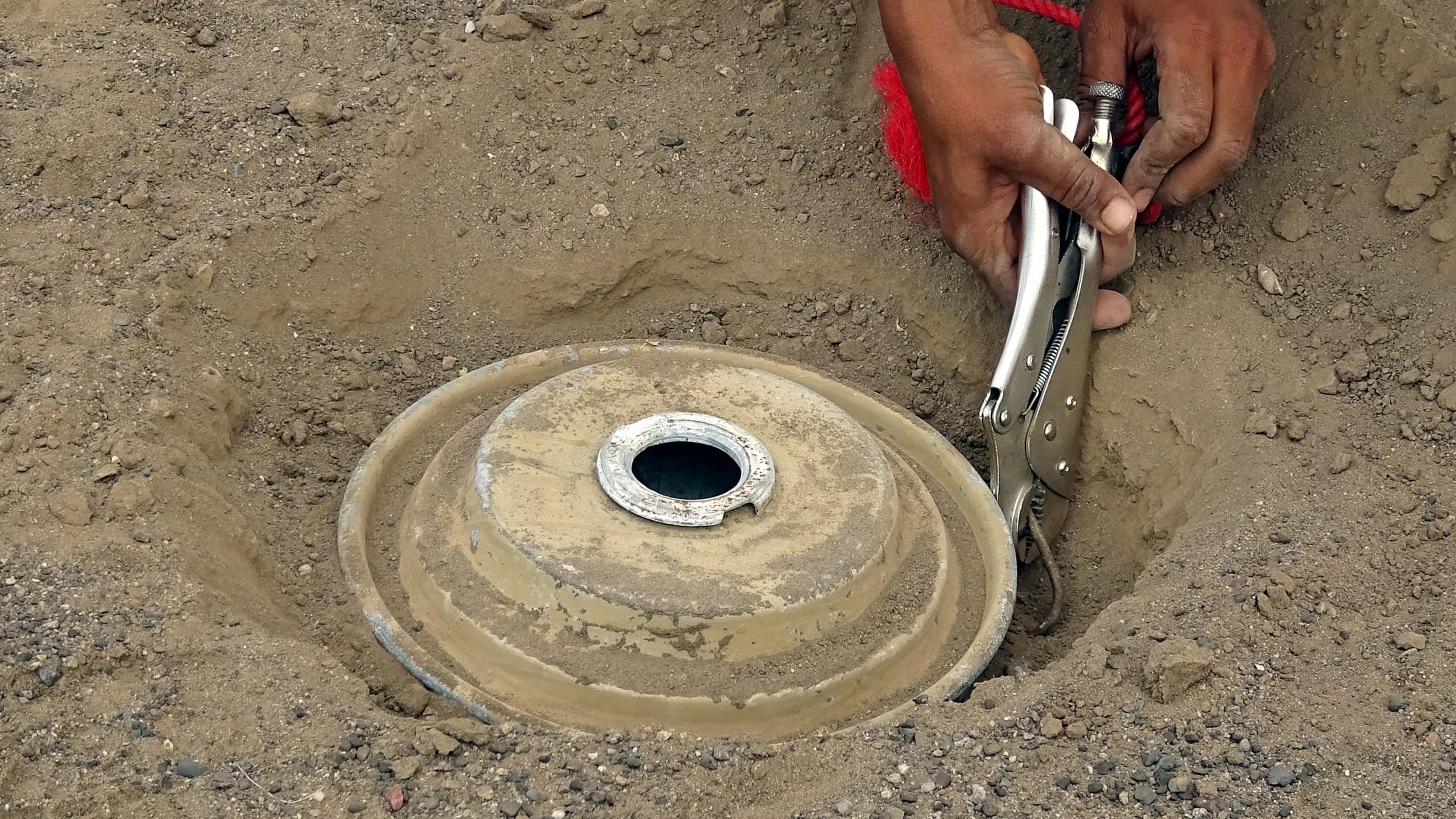The Kingdom
Vs. Landmines
400 Yemenis have been killed by mines since 2019, a Saudi-led initiative endeavors to end this
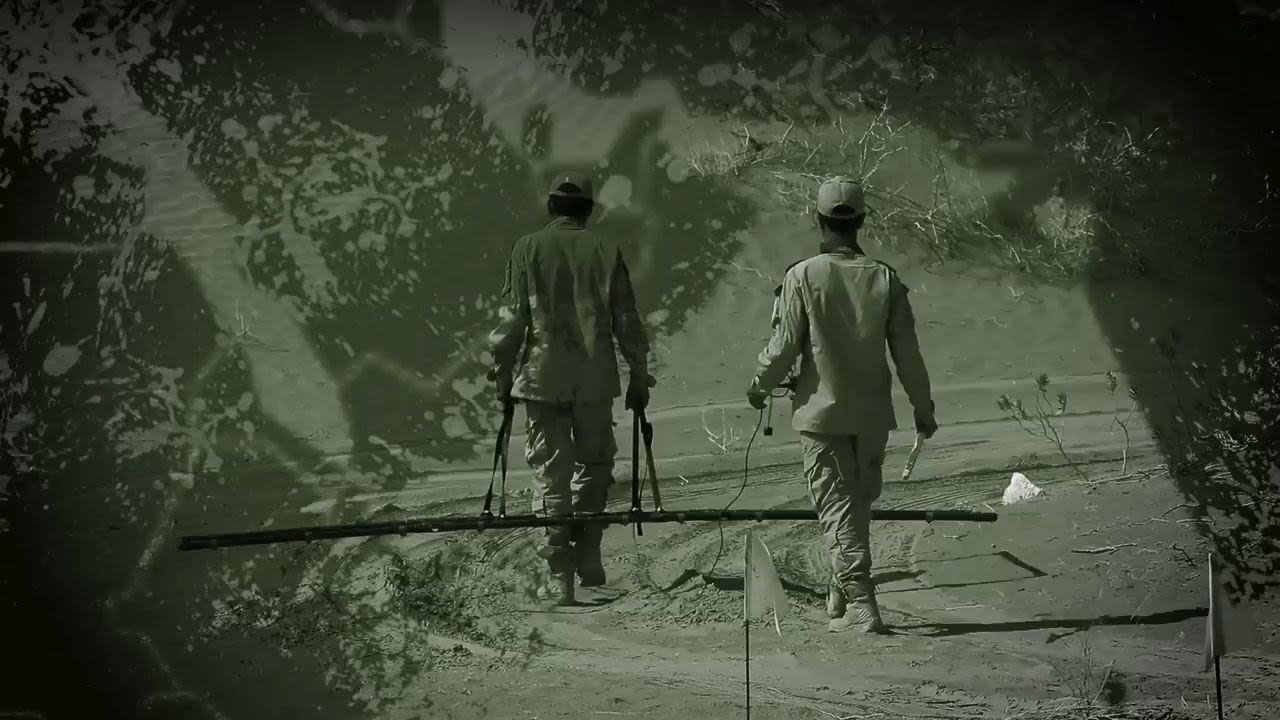



The bus drove over a landmine…shooting tatters of the children’s bodies out of the windows and turning the village’s wedding into a funeral.
Sep. 13, 2021 | Al-Khawkhah District, south of Hodeidah
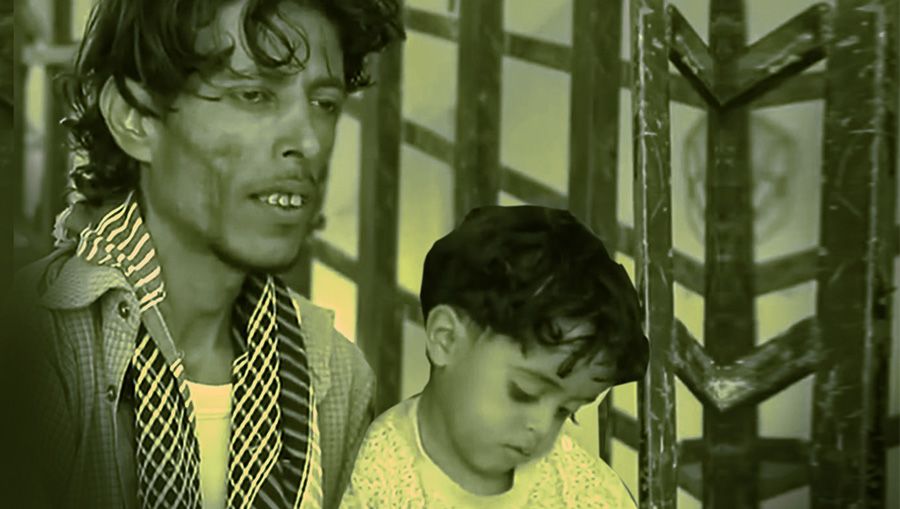

On their way to the nearby clinic, a Houthi-planted landmine turned their bodies to pieces and claimed the little boy’s leg.
Oct. 30, 2022 | Taiz
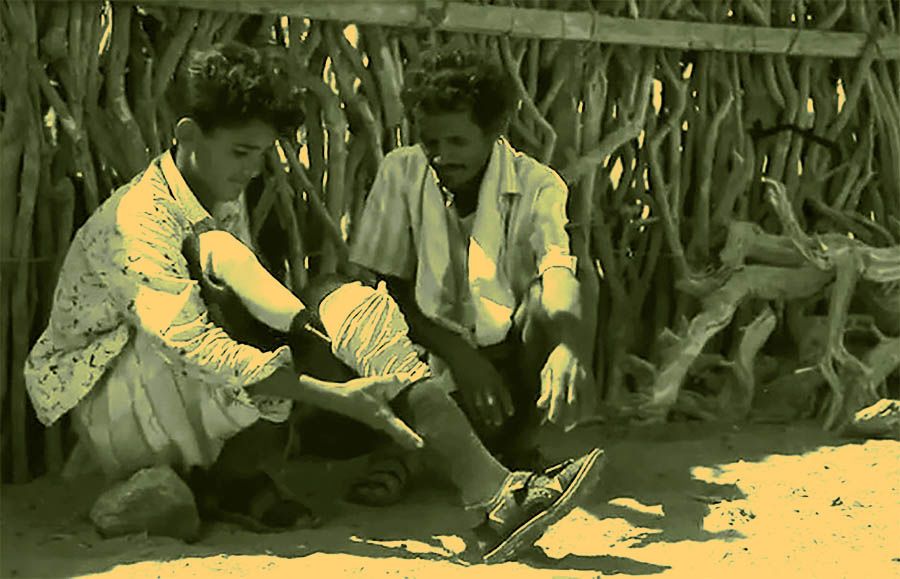

My son lay on the ground, bleeding, his leg severed, hanging to his body by nothing but some skin.
2021 | Dhubab
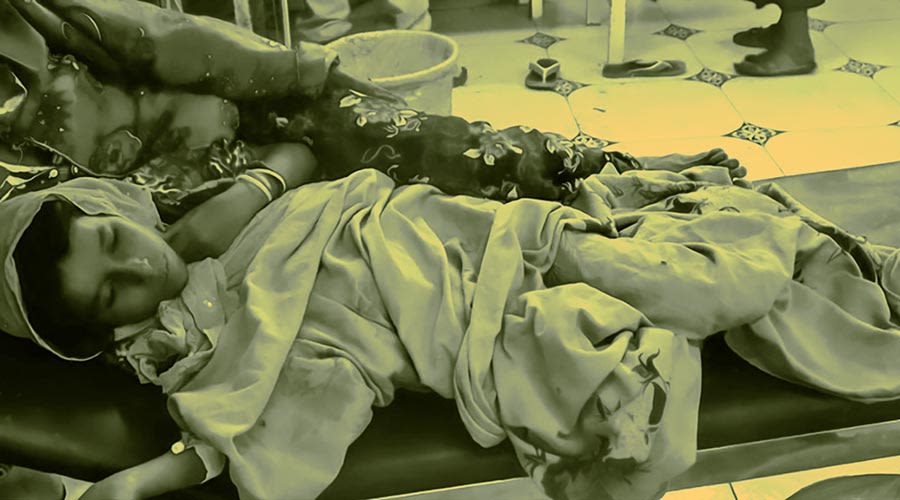

Sameera, 9, lost her right foot after stepping on a landmine while chasing her ball.
Al-Durayhimi District | south of Hodeidah
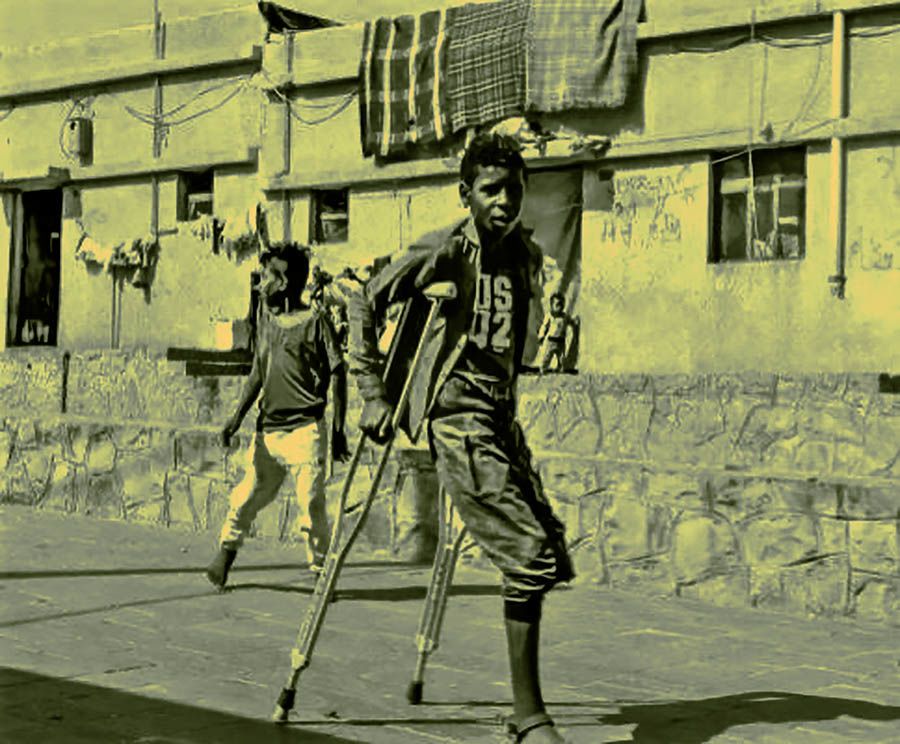

Muhannad, 8, lost a leg and a hand on a trip to the weekly Zangal market, which was riddled with Houthi land mines.
Nov. 25, 2015 | Al-Turbah District
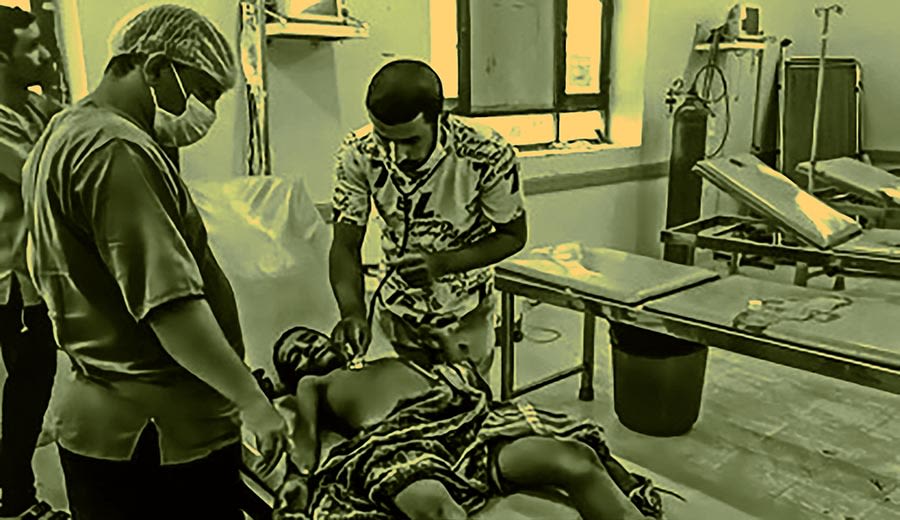

Sadek’s parents passed out at the sight of blood gushing out of their son’s body after he stepped away to fetch them water.
Sep. 15, 2021 | Al-Qataba

With the hope of finding the perfect dress, Amal set out to Taiz ahead of her much-anticipated wedding day. However, the sight of a group of young children playing with a “suspicious object” at the city’s gate brought back a vivid, forewarning memory.
“It looked like something my father had been holding a while ago,” she said. “He had warned us against touching these weird objects we might see in the streets.”
Concerned, Amal frantically took the object from the children “so it wouldn’t explode and hurt them.”
Innocently mischievous, one of the children snatched the gadget back, but it fell and hit the ground.
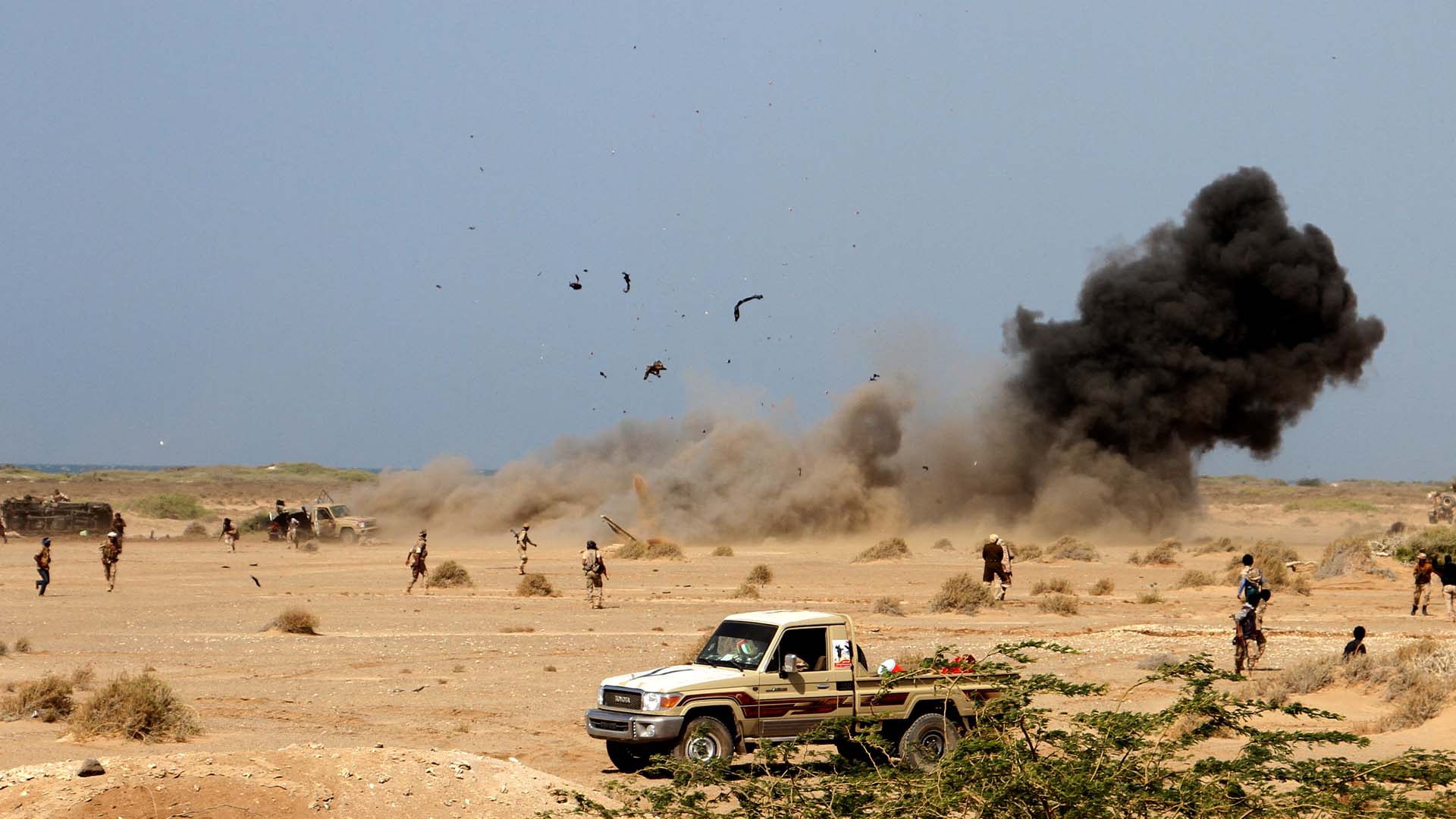
Amal faced bullying at university and in public places due to her injuries, but that did not stop her from pursuing a degree and getting a job.
Amal faced bullying at university and in public places due to her injuries, but that did not stop her from pursuing a degree and getting a job.
“I no longer felt anything until I woke up in a hospital, where I realized my arm and eye had been injured,” she said.
Today, Amal has a prosthetic eye.
“My fiance cut contact with us, and my marriage never happened,” she said. “After a while, we heard that he got engaged to another girl.”
Amal is not the only — nor will she be the last — casualty of a devious maimer that lurks beneath people’s feet.
A ‘deadly legacy’ that harvests lives, limbs and livelihoods
Since the war began in 2014, Houthi militants have laid thousands of land mines across vast swathes of land, putting civilians’ lives and livelihoods at risk even during cease-fire.
“Across Yemen, mines and other explosive ordnances are a deadly legacy of the conflict,” said Cherry Franklin, humanitarian policy adviser for the Danish Refugee Council in Yemen.
Hadeel Mohammed Abdul Wase, a missile attack survivor who lost both arms after a Houthi raid struck her home in Kedha, west of Taiz, recalled how “the majority of the people have lost an arm or a leg, while others met death, lost sight or other parts of their bodies.”
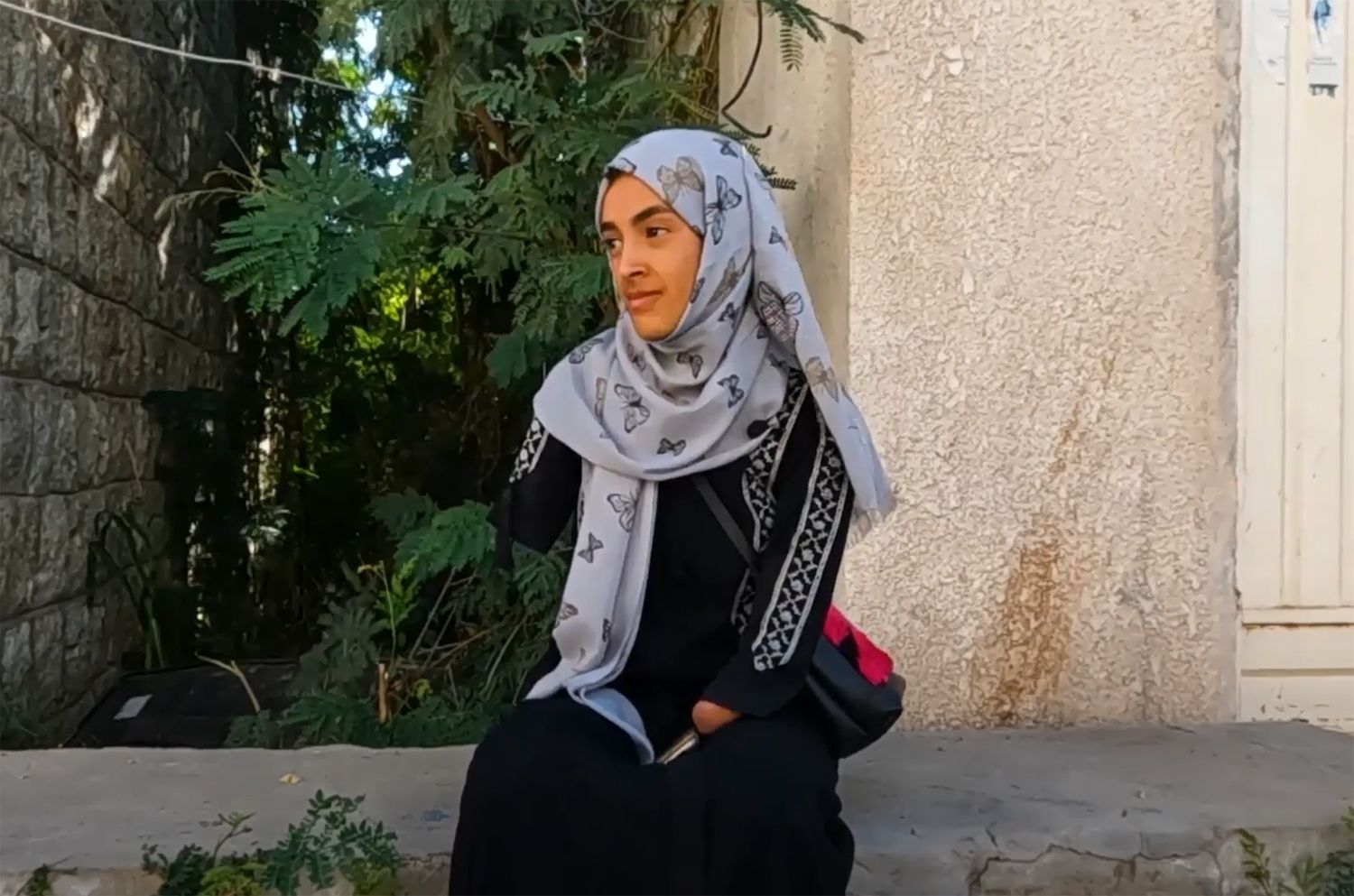
After losing both of her arms, Hadeel found day-to-day activities challenging but later adapted to her new life.
After losing both of her arms, Hadeel found day-to-day activities challenging but later adapted to her new life.
Condemning the Houthi militias, Hadeel said: “Instead of planting seeds of hope in our land, they are planting seeds of obscenity and evil.”
“They select the paths people take as locations to plant chains of mines instead of a single exploding device,” she said. “They are ruthless and cold-hearted. All they want is to raze the nation to the ground, including military personnel and citizens.”
“The seeds of failure are planted in our land. Plant hope and future seeds instead of these demolishing mines. There is no future in Yemen until mines are completely removed from our land.”
Large, barren swathes of desert land are found between Yemeni cities — fertile land for planting APls and other malicious mines below the feet of unsuspecting travelers… many of whom are farmers, traders and even children.
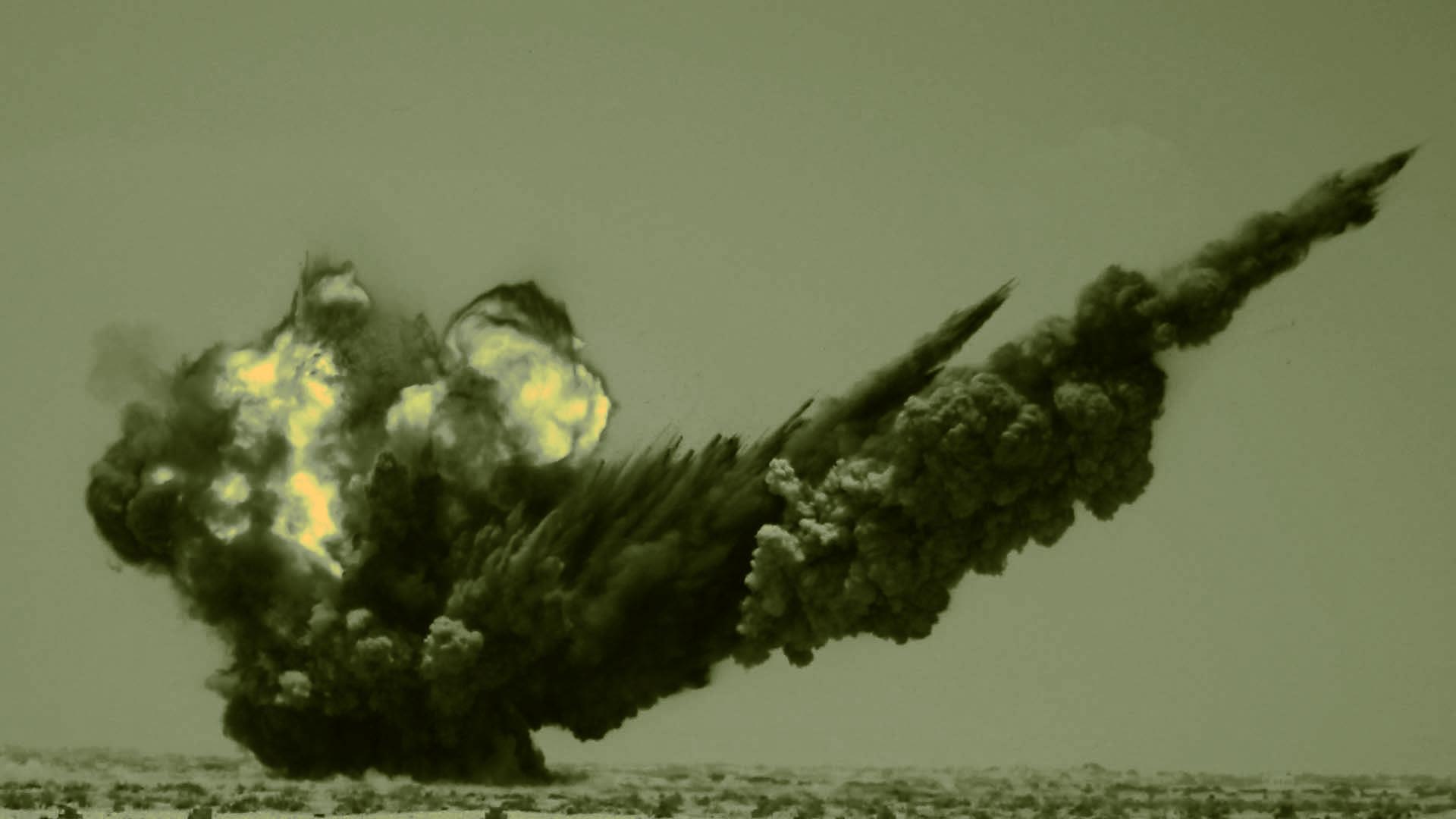


Throughout the UN-brokered truce, which stretched from April to October 2022, at least 40 people were killed every month by land mines, unexploded munition and improvised explosives, according to the Washington-based Center for Strategic and International Studies.
“Mines (in Yemen) cause civilian casualties almost on a daily basis, especially in parts highly contaminated by these explosive devices, such as Hodeidah on the Red Sea and other governorates, including Taiz, Al-Bayda, Marib, Shabwa, Jouf and Hajjah,” said Fares Al-Hemyari, executive director of the Yemeni Landmine Records, comprised of a group of volunteers who document land mine casualties across the country.
He said that in the first two months of 2023, his initiative “recorded 43 civilian deaths and 78 injuries (by land mines), most of whom were children and women.”
Children and internally displaced people are “particularly vulnerable,” a Save the Children report published in March noted, highlighting that “out of 194 child victims of EO supported by Save the Children between (Jan.) 2020 and (Nov.) 2022, nearly 1 in 4 were IDPs (internally displaced people),” of which 80 percent were women and children.
The report, “Watching Our Every Step,” revealed that in 2022, more than half of Yemen’s child casualties were caused by land mines.
“I nearly lost my mind when I saw my son’s leg, severed and connected to the rest of his body by nothing but a thin strip of flesh, while blood gushed out of several other wounds in his emaciated body,” said the father of 15-year-old Radwan, who in 2021 stepped on a concealed mine while shepherding the family’s sheep.
Although Radwan has survived, he lives with permanent physical disability.
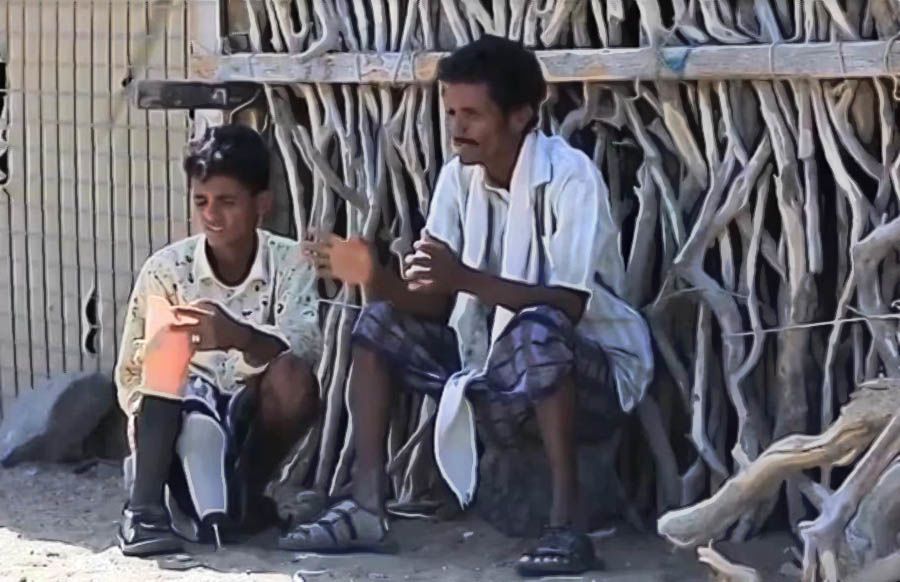
Radwan’s town Thabab lost dozens of children after the Houthi militias riddled the ground with mines.
Radwan’s town Thabab lost dozens of children after the Houthi militias riddled the ground with mines.
Medecins Sans Frontieres predicted this rise in land mine victims at Abs General hospital in Hajjah governorate. This was “largely due to the increased mobility of the community (internally displaced people and host community) in accessing their abandoned farmlands, which used to be close to the frontlines, or looking for grazing lands or fishing as people are desperate for survival,” the head of MSF’s Yemen mission, Caroline Ducarme, told Arab News.
“The high number of people seeking treatment at (Abs) hospital has left staff and essential services overwhelmed,” she said. “Our teams have worked in the hospital since 2015, but today we are stretched to the limit.”
Mines and other explosive ordnance have also prevented internally displaced people from returning to their homes, accessing vital services and restarting their livelihoods, said Cherry Franklin of the Danish Refugee Council in Yemen.
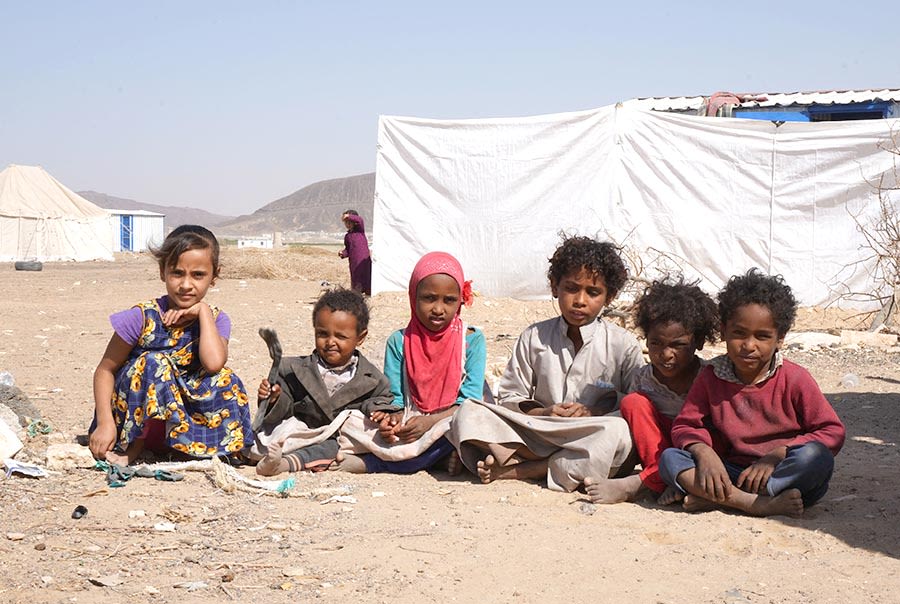
IDPs are ‘particularly vulnerable’ to the threat of landmines, explosive ordnance and unexploded munition, says Save the Children. (AFP)
IDPs are ‘particularly vulnerable’ to the threat of landmines, explosive ordnance and unexploded munition, says Save the Children. (AFP)
Internally displaced people besieged by land mines have also been deprived of much-needed humanitarian aid while unable to make ends meet. Human Rights Watch said in a 2019 report, “Yemen: Houthi Landmines Kill Civilians, Block Aid,” that Houthi-laid land mines had, since mid-2017, “prevented aid groups from reaching vulnerable communities.”
The predicaments of internally displaced people are compounded by a shortage of appropriate funding for humanitarian organizations providing aid in Yemen as well as environmental hazards, such as floods and sandstorms, which can also cause a shift in the devices’ locations, explained Save the Children in its report.
“It is vital that across Yemen there is access to remove mines in line with international standards and that the international community provides the support to ensure this happens quickly and effectively,” said Danish Refugee Council’s Franklin.
Franklin said that “even if the conflict in Yemen ends, without increased humanitarian mine action to clear contamination, the lives of people in Yemen will continue to be put at risk.
“Farmers will not be able to access their land, children will be forced to walk through minefields to get to school and many of those displaced by the conflict will be unable to return home or rebuild their lives.”
MSF’s Ducarme said that land mines aggravated malnutrition by posing yet another “obstacle to ensuring food security,” not only because they hindered aid delivery, but also as people “face (the) risk of land mines when moving to look for livelihood opportunities that they are in dire need for to be able to be able to cover their basic needs.”
“Last year, we faced an early onset of the malnutrition peak coupled with high numbers of severely malnourished children needing to be admitted for care, which has overwhelmed MSF-supported facilities,” she said, highlighting that among the “many underlying causes for malnutrition in Yemen” was the lack of affordability of food.”
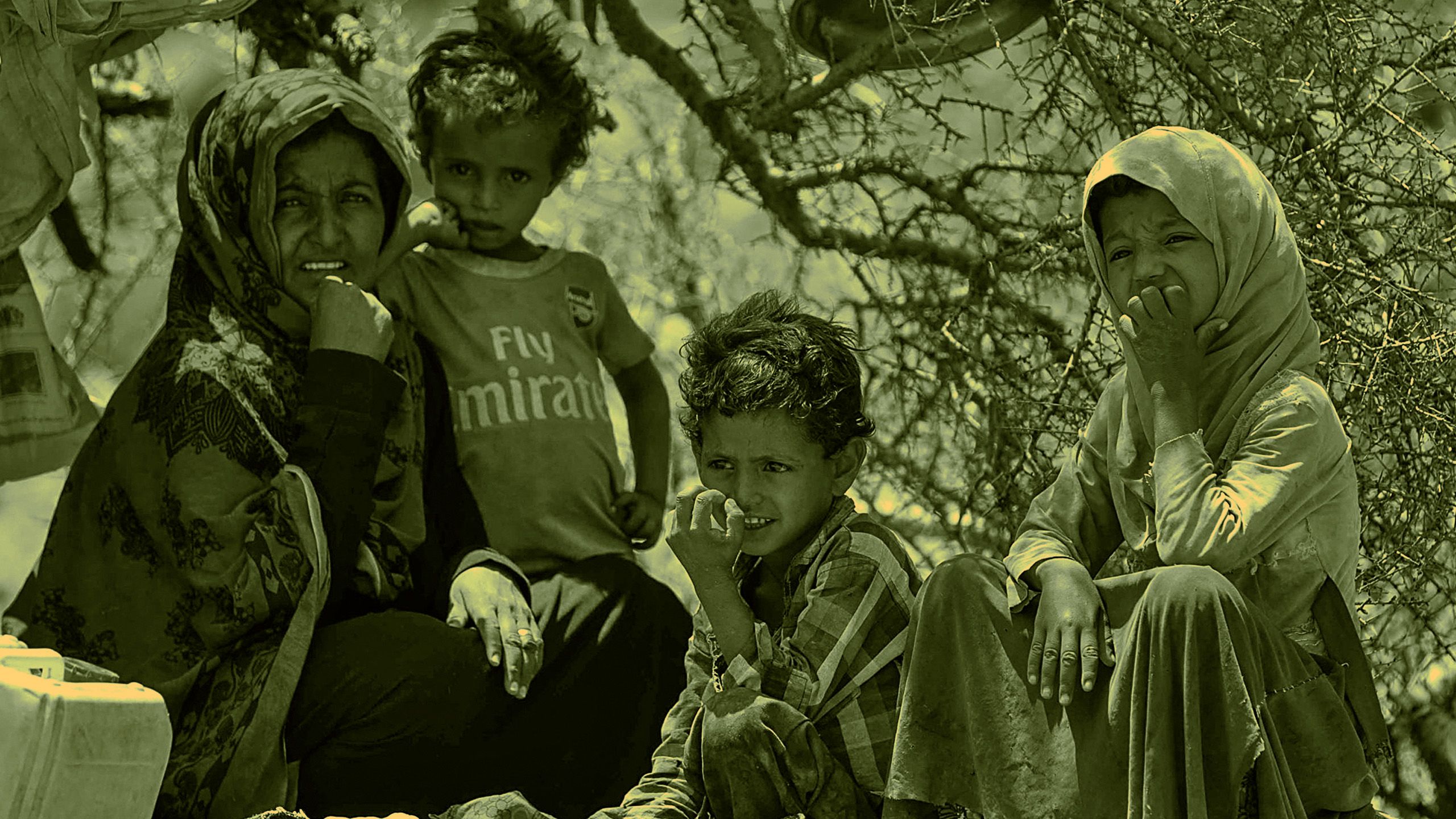
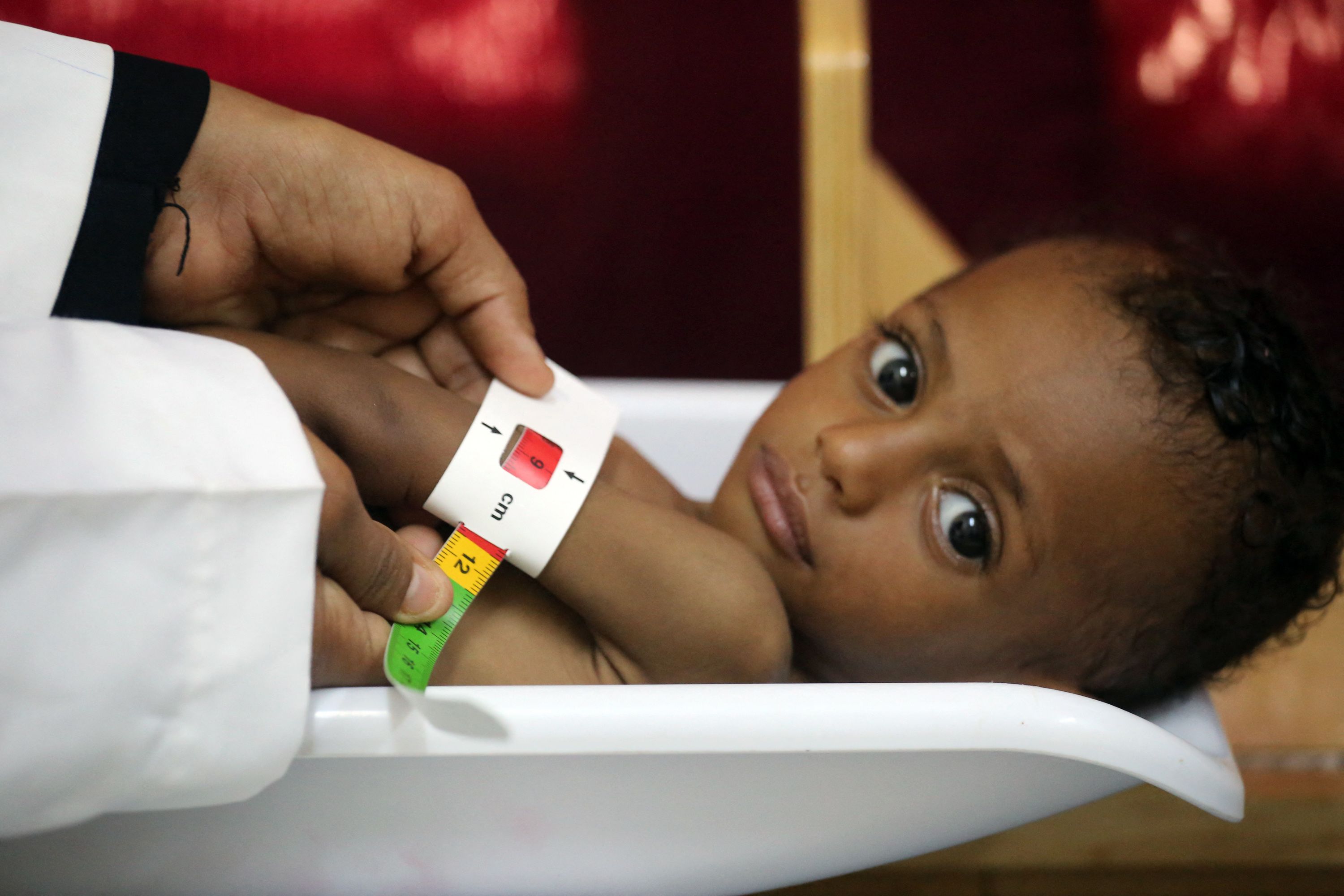
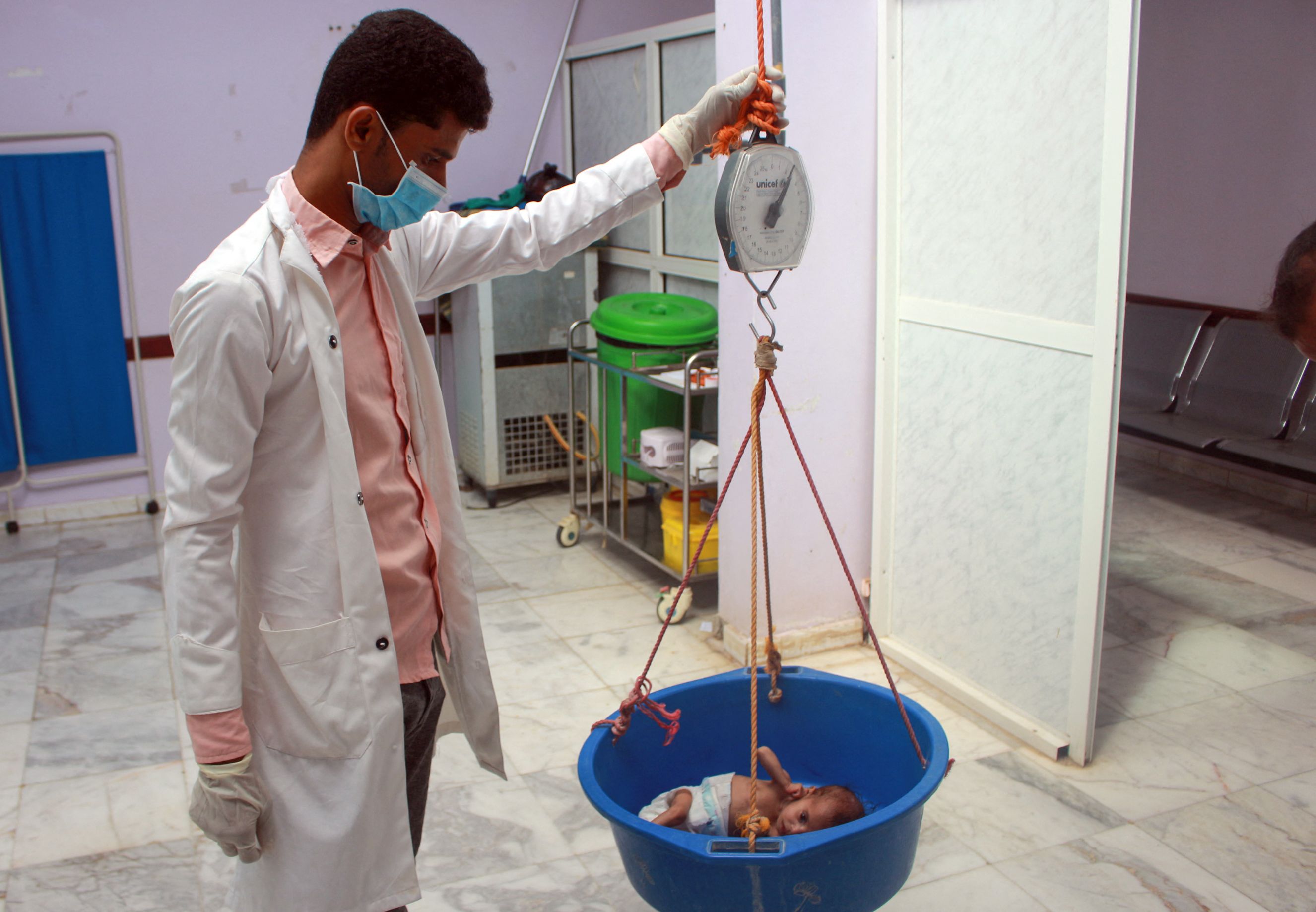

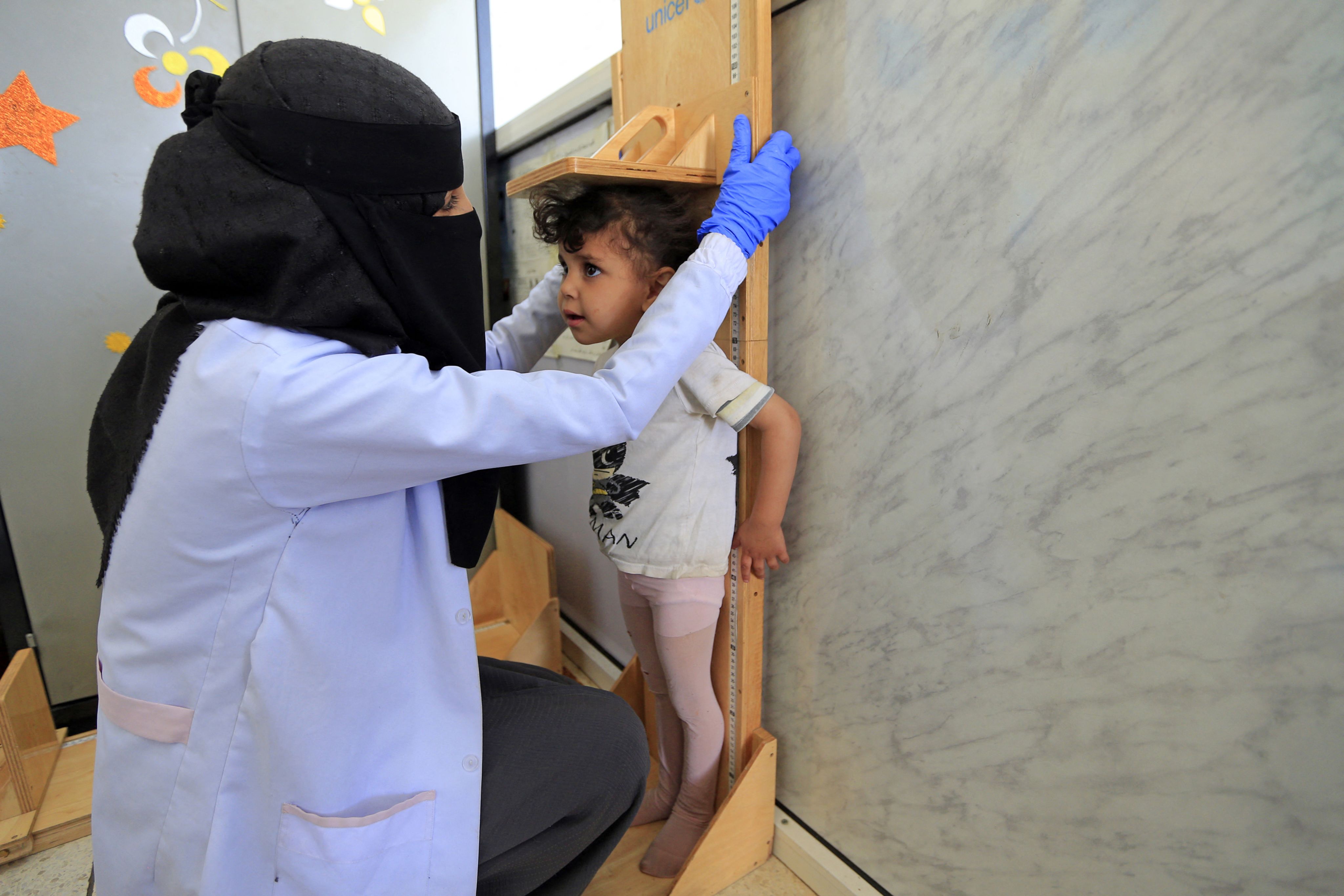

A 2022 survey by WFP showed that about one-third of families in Yemen have gaps in their diets. (AFP)
A 2022 survey by WFP showed that about one-third of families in Yemen have gaps in their diets. (AFP)

2.2 million children under 5 require treatment for acute malnutrition, says WFP. (AFP)
2.2 million children under 5 require treatment for acute malnutrition, says WFP. (AFP)

One of the main causes of malnutrition in Yemen is high food prices, says MSF. (AFP)
One of the main causes of malnutrition in Yemen is high food prices, says MSF. (AFP)

Six NGOs came together in 1992 to put an end to the use of landmines. (AFP)
Six NGOs came together in 1992 to put an end to the use of landmines. (AFP)

Demining efforts in a land plagued with mines
Since its launch in mid-2018, Masam — Saudi Arabia’s demining project in Yemen — has cleared 390,586 mines in the regions from which the Houthi militants have withdrawn.
However, due to the presence of large quantities of mines as well as a lack of maps to accurately identify areas of contamination, it will take years to remove and destroy all land mines planted across the county, explained the project’s managing director, Ousama Al-Gosaibi.
Removed and neutralized explosives during that period included 6,065 anti-personnel mines, 137,197 anti-tank mines, 7,741 explosive devices and 239,583 unexploded ordnances.
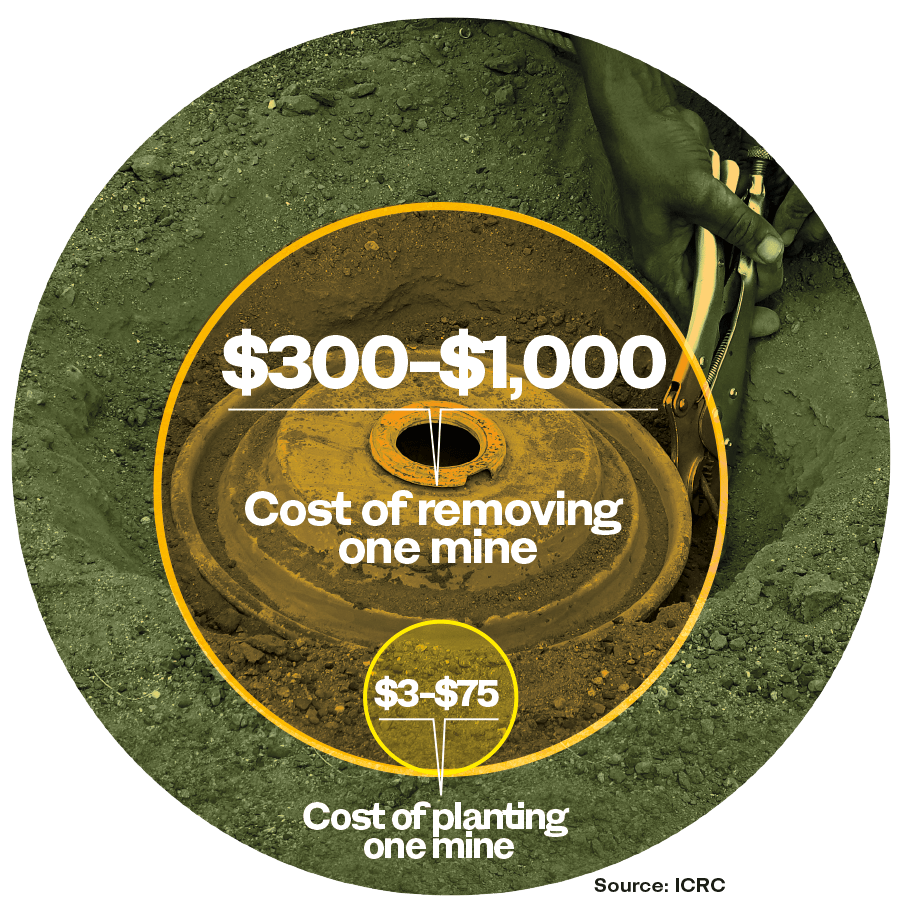
About 44,635 million sq m has been cleared, according to Masam data — which is overseen by the King Salman Humanitarian Aid and Relief Center — with areas cleared primarily covering farms, roads, schools, hospitals and water wells.
Al-Gosaibi said that “besides removing the mines, the project also works on destroying them to ensure that they are not used again,” adding that Masam’s engineering teams handle all recognizable land mines, in addition to similar devices manufactured locally in Houthi labs.
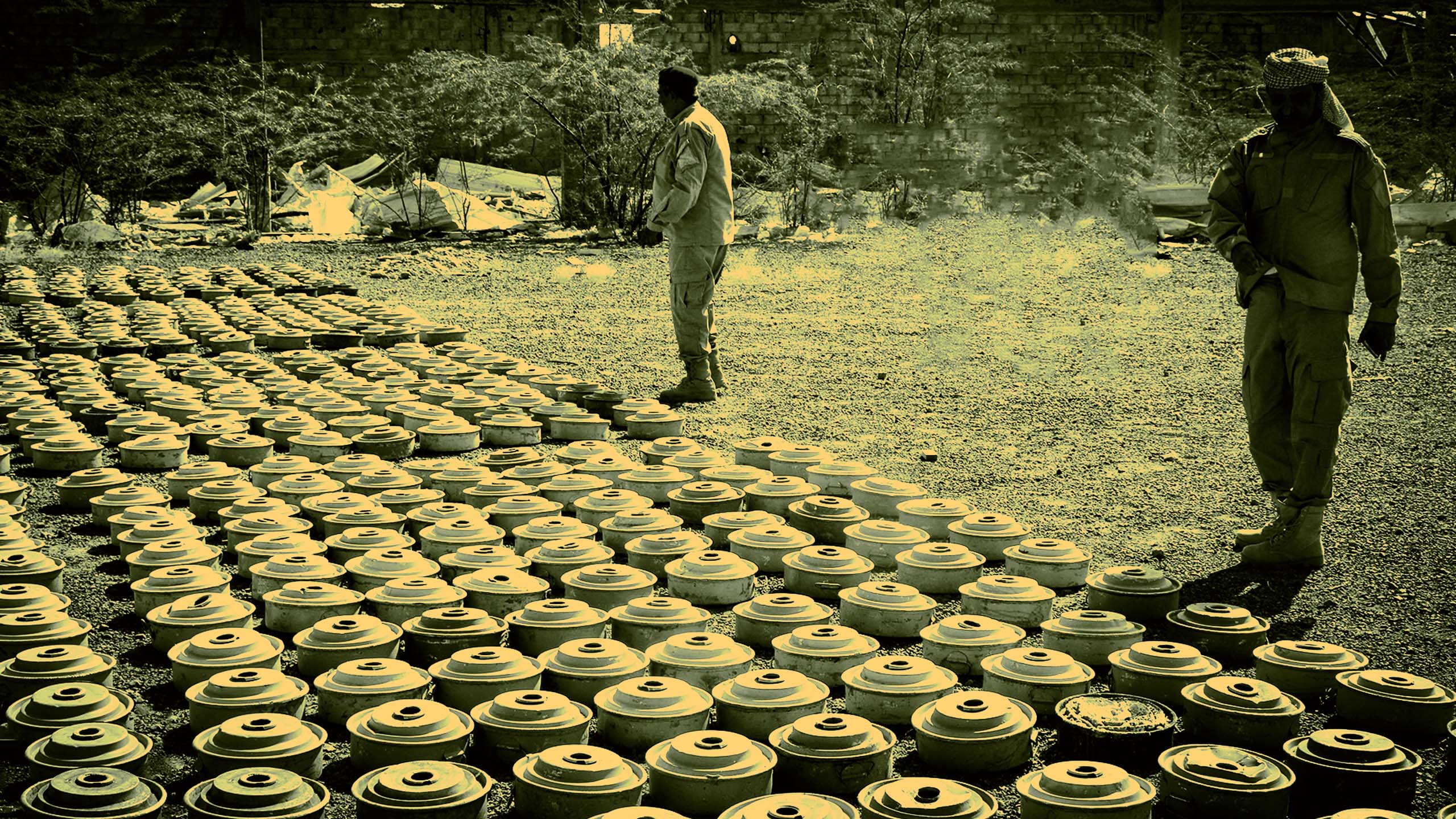
To Masam, locally made land mines are a major concern.
“Imagine stumbling on an anti-tank land mine that has been transformed into anti-personnel mine on your way back from your land. Imagine targeting a classroom with explosives. This is the harsh reality of living in Yemen today; every step might kill you,” Al-Gosaibi said.
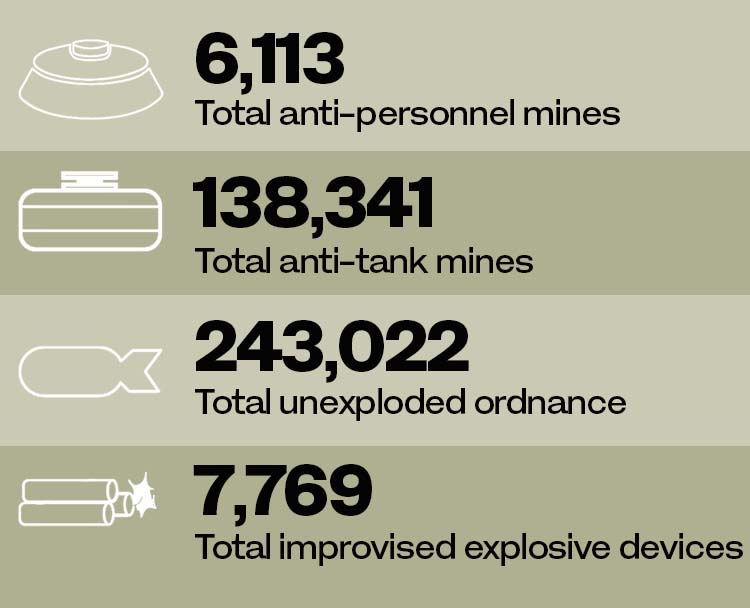
“What is sad is that these explosives do not differentiate between people. Thousands of Yemenis die or lose limbs every year, and this is why the Masam project works relentlessly on eliminating the threat of land mines in Yemen. In order to ensure Yemen’s ability to rebuild safely, we train and oversee local deminers, who are risking their lives to help others.”
In addition to working with 550 experts, deminers and other employees, Masam has trained and equipped 32 engineering teams.

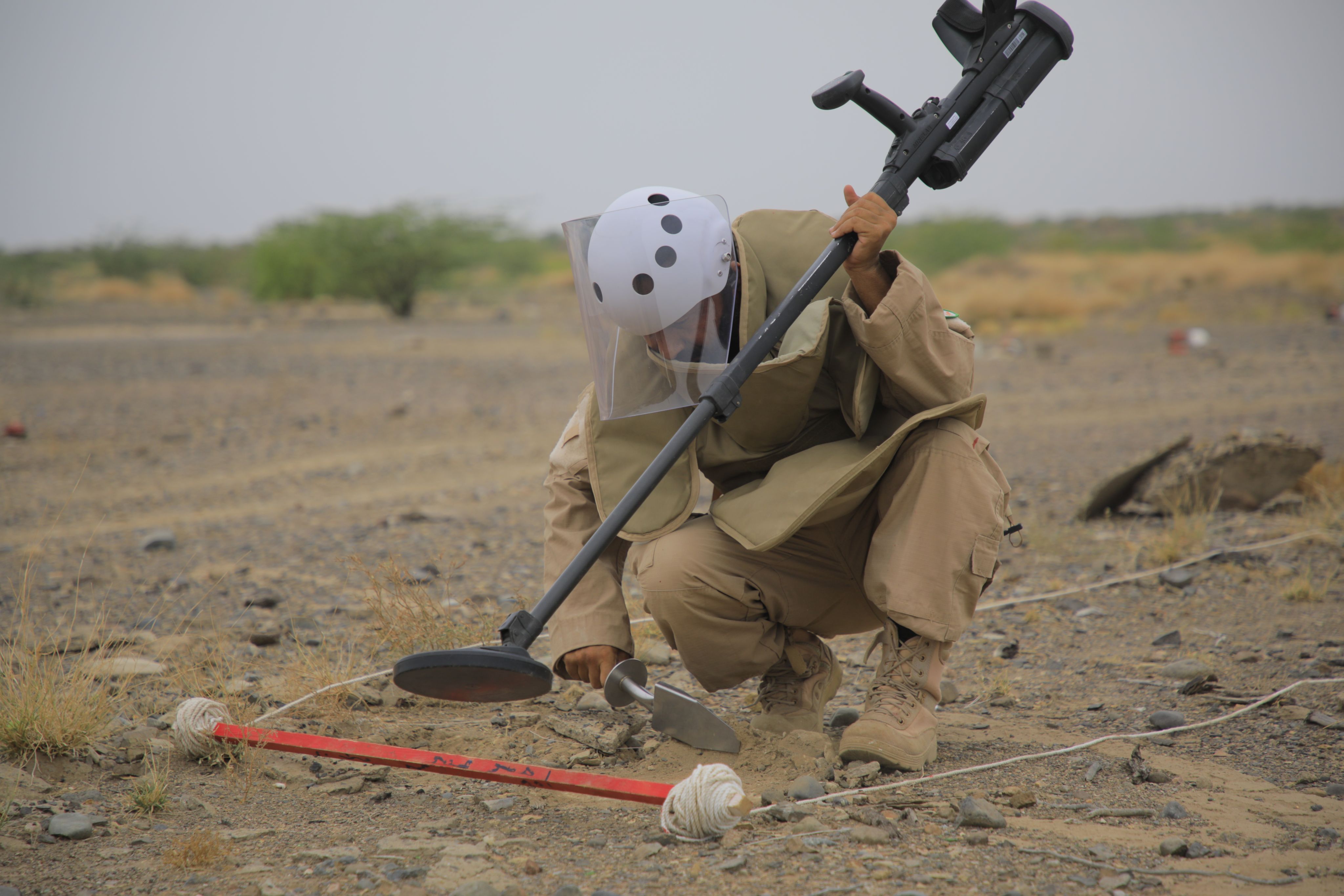
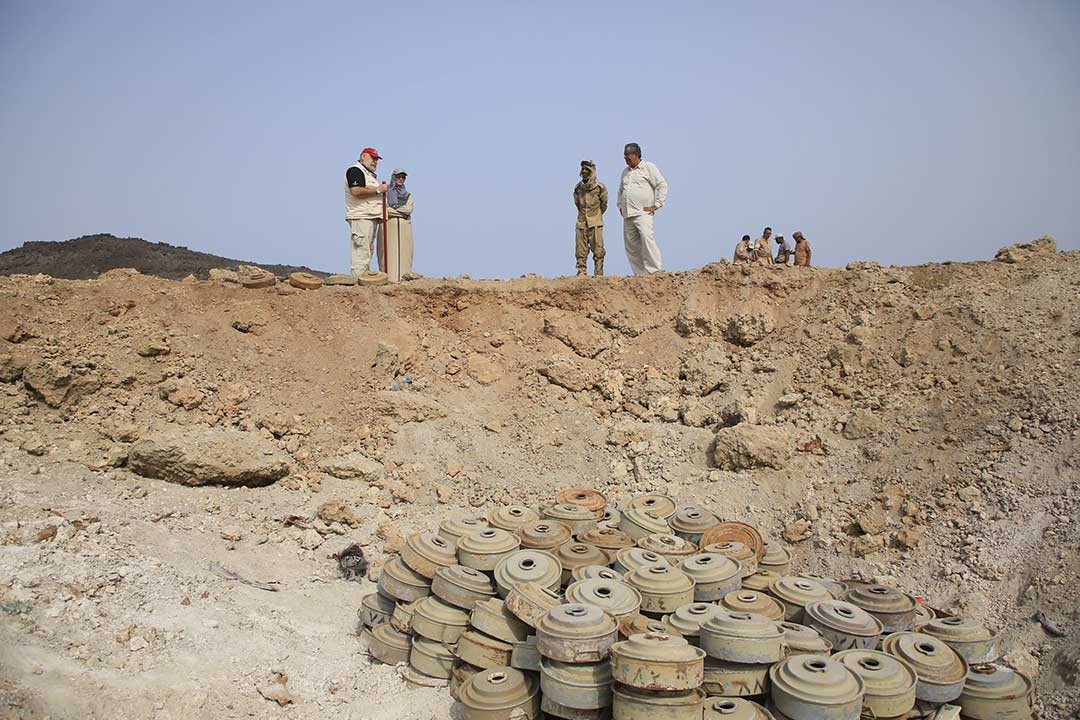
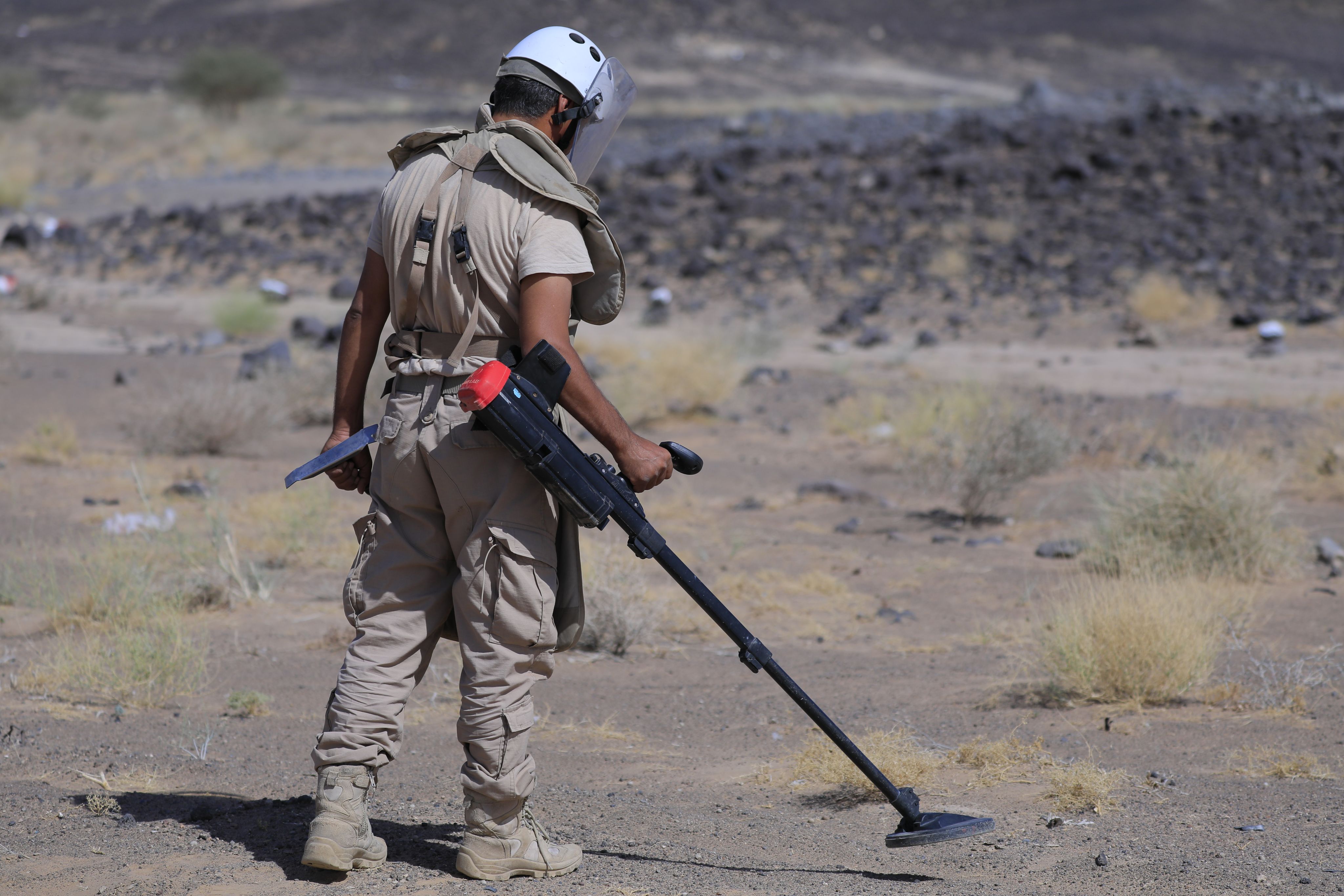
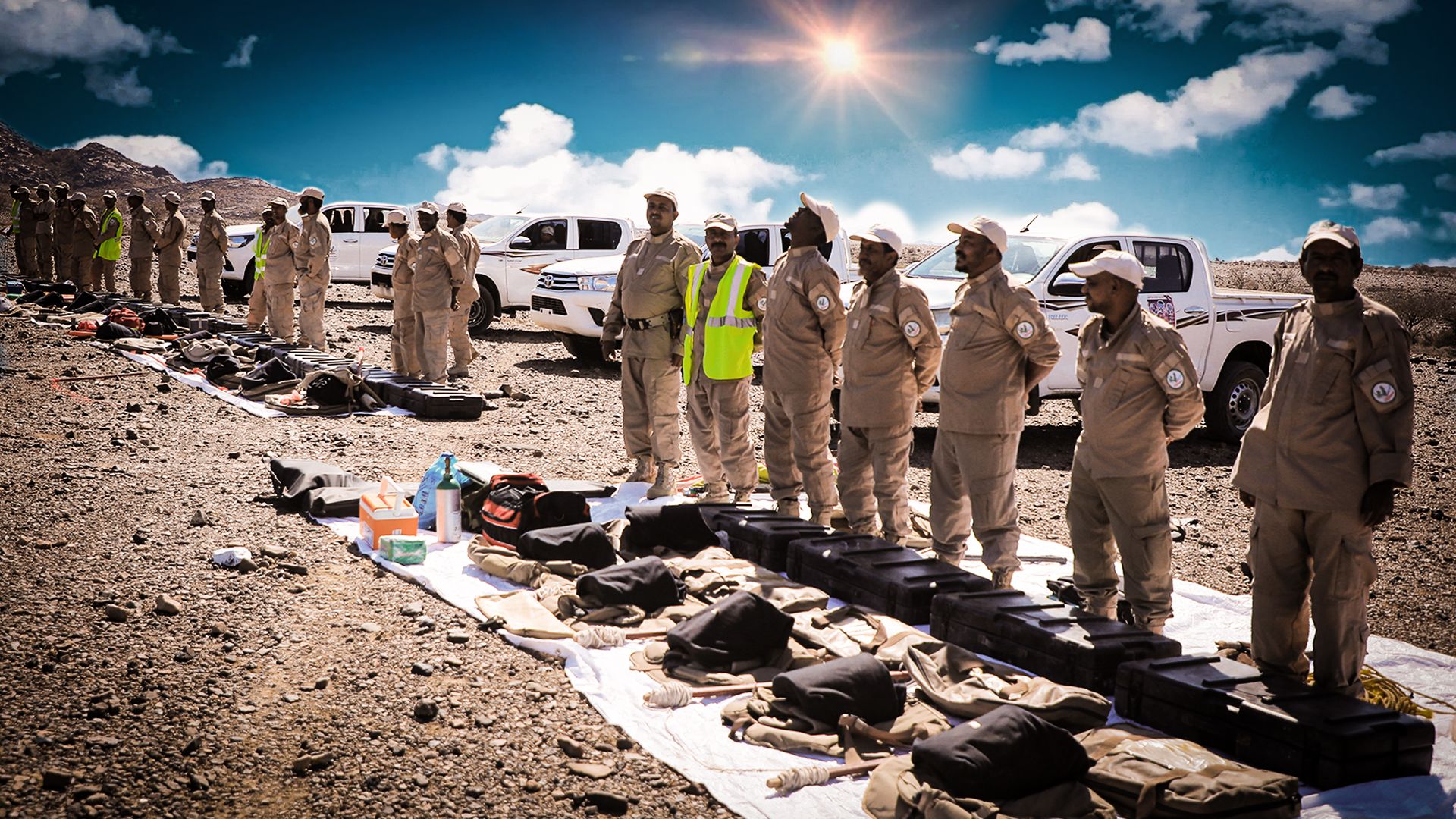

Demining efforts in Yemen would take years due to the large number of devices laid and a lack of maps showing their locations.
Demining efforts in Yemen would take years due to the large number of devices laid and a lack of maps showing their locations.

KSRelief’s Project Masam cleared 390,586 mines since mid-2018 in freed Yemeni regions.
KSRelief’s Project Masam cleared 390,586 mines since mid-2018 in freed Yemeni regions.

Locally manufactured mines are a major concern for Masam.
Locally manufactured mines are a major concern for Masam.

Masam’s team members are all young Yemeni nationals, says operations manager Zawbaa Al-Rawi.
Masam’s team members are all young Yemeni nationals, says operations manager Zawbaa Al-Rawi.
Yemen was first Arab state to destroy stockpile after Mine Ban Treaty adoption
Although historically afflicted by land mines due to repeated conflict, namely between the 1960s and 1990s, Yemen “was the first Arab country to destroy its stockpile of antipersonnel mines completely” after signing the Mine Ban Treaty in 1997 and ratifying it the following year, according to the Carnegie Endowment for International Peace.
“Yemen was close to officially declaring itself a mine-free zone in early 2014, after years of efforts to clear affected areas,” said Al-Hemyari of the Yemeni Landmine Records, “but the return of violence at the end of that year sent the country to point zero.
“Today, (Yemen) is one of the world’s most contaminated regions.
Despite reports of land mine use during the American Civil War, these silent killers were not recognized as a serious problem until they were extensively deployed in World War II. A 1993 paper, “The Cowards’ War: Landmines and Civilians,” said that “Germany, Italy, Britain and France laid between five and 19 million mines in North Africa alone.”
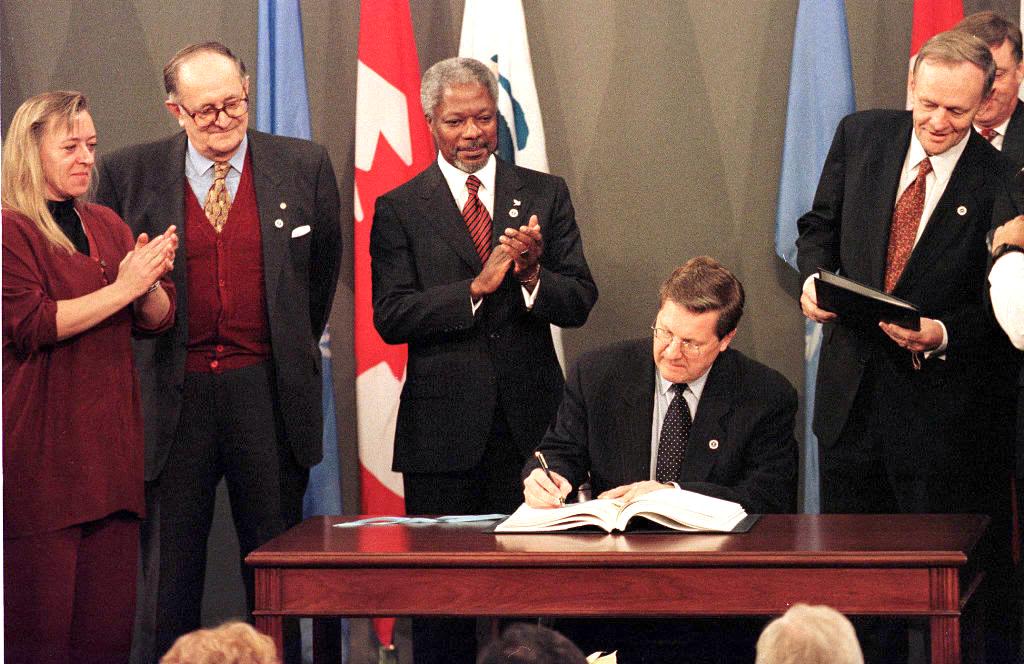
Six NGOs came together in 1992 to put an end to the use of landmines. (AFP)
Six NGOs came together in 1992 to put an end to the use of landmines. (AFP)
The representatives of 122 countries met in Ottawa, Canada in 1997 to produce a treaty that aims to eradicate land mines, therefore protecting civilian lives. The Mine Ban Treaty, formally called the Convention on the Prohibition of the Use, Stockpiling, Production, and Transfer of Anti-Personnel Mines and on their Destruction, was by August 2022 ratified or observed by 167 nations.
The treaty entered into force on March 1, 1999, banning the use, production, stockpiling and transfer of antipersonnel mines, and obligating states to clear contaminated areas, destroy stockpiles and support victims.
Jared Bloch, communications manager at the International Campaign to Ban Landmines-Cluster Munition Coalition, said that the Ottawa Convention “shifted the disarmament narrative toward human security, put victims at the center of the discussion, and provided a template for subsequent disarmament treaties.”

Since the treaty’s adoption in 1997, “the number of people killed and injured by land mines has decreased dramatically,” he said.
Nevertheless, civilian safety was not guaranteed as non-state militant groups, such as the Houthis, continued to lay land mines.
Civil society organizations, with the support of the relevant NGOs, have since been relentlessly pushing for the elimination of mines and explosive ordnance.
“A good example of how civil society organizations contribute to eliminating (the) use of land mines by non-state actors is the work of our member Geneva Call,” Bloch said. “The organization has facilitated dialogue and negotiation with, and declarations by, non-state groups stating commitment to the principles of international humanitarian law and publicly renouncing the use of mines as indiscriminate weapons.”
“The Mine Ban Treaty continues to be incredibly relevant today,” he said.
“Extensive mine use by a small number of states outside the treaty, including Myanmar, Russia and Syria, and non-state armed groups in conflicts in Colombia, Yemen and elsewhere, means a prolongation of this terrible legacy of killing and maiming civilians; girls, boys, women and men.”


A noble goal that costs lives
“The terrorist Houthi militia had reached us . . . and planted mines on roads and in houses, farms, schools, water wells and hospitals,” said Mohamed Saleh Maraani, a resident of Moussa district in Taiz.
“We could not return to our homes, to our mosques, and to our schools. Our ways of life were destroyed.”
Masam’s efforts to clear affected areas comes at a significant cost, with it having lost many of its team members.
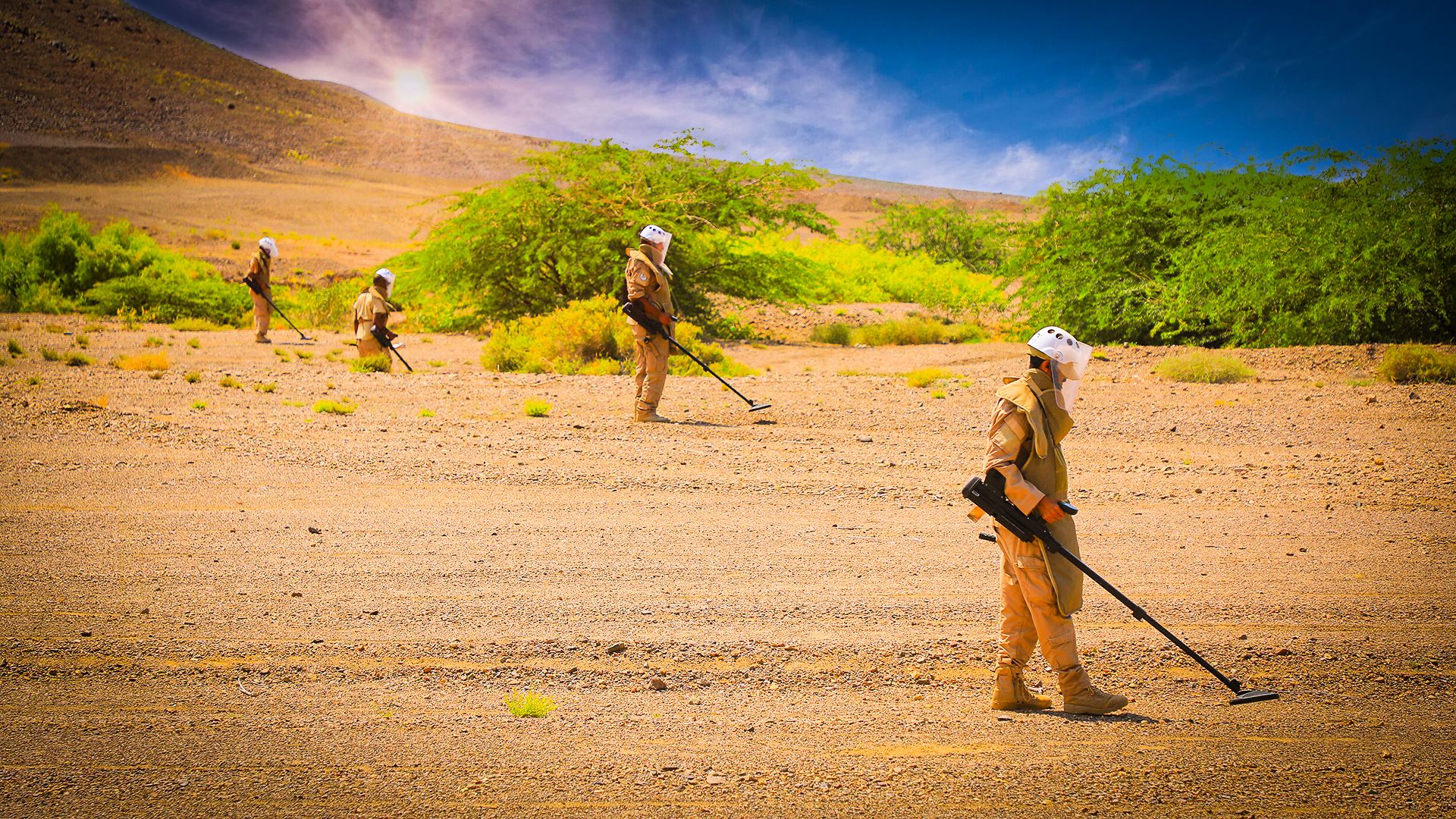
Masam not only removes the mines but also destroys them, says managing director Ousama Al-Gosaibi.
Masam not only removes the mines but also destroys them, says managing director Ousama Al-Gosaibi.
Al-Mahmoud, the project’s PR and media director, said that the mine-clearance process had caused the death of 30 workers, including five foreign experts, and the injuring of at least 52 others.
“They sacrificed their lives doing a great humanitarian job to restore peace in Yemen,” Yemeni Human Rights Minister Mohammed Mohsen Askar told Arab News at the time.
These tragic incidents, however, did not dissuade Masam’s team from persevering with their demining efforts.
Zawbaa Al-Rawi, Masam’s manager of operations in Aden and the west coast of Yemen, said that Masam’s team members were all young Yemeni nationals, who, armed with national pride and respect, willingly joined the cause.

Demining has cost Masam 30 team members who died in the process.
Demining has cost Masam 30 team members who died in the process.
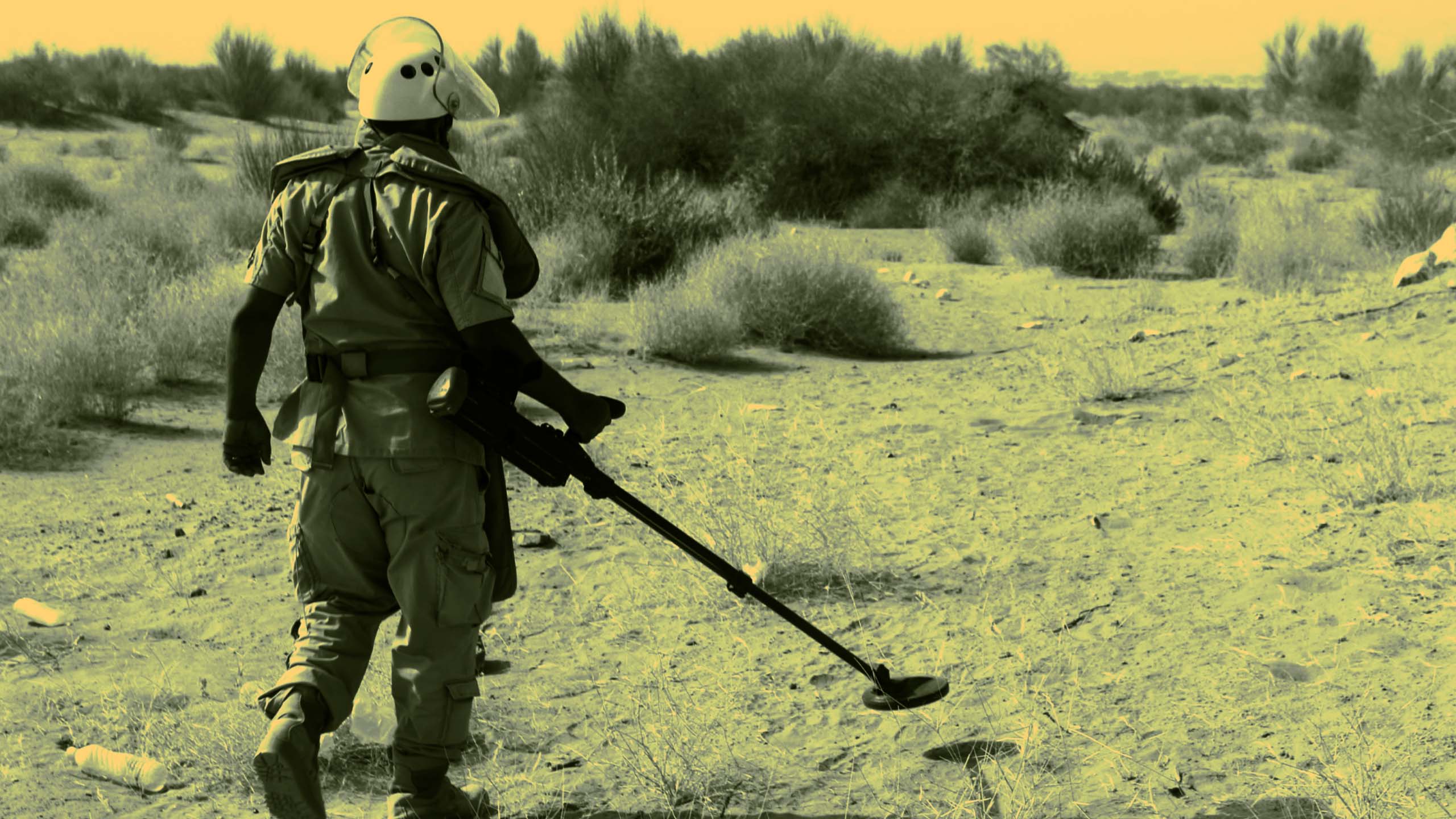

Chris Clark, director of special projects at SafeLane Global Ltd, a UK-based company specializing in explosive ordnance mitigation and humanitarian demining, said that land mine clearance was achieved “through the deployment of 32 Yemeni demining teams . . . managed, coordinated, equipped, supported, trained and ensured by Masam.”
He said that Masam’s work not only saved civilian lives but paved the way for a better future countrywide.
“Our work is not only lifesaving in the immediate sense, but also every mine and every square meter that they clear is a piece of land that won’t need to be addressed when the country is finally at peace,” he said.
“So, it is an investment in the future reconstruction and rehabilitation of Yemen as a country and as a people.”
Credits
Writing & Research: Mohammed Al-Sulami, Anan Tello
Editor: Tarek Ali Ahmad
Creative director: Omar Nashashibi
Designers: Douglas Okasaki, Omar Nashashibi
Graphics: Douglas Okasaki
Head of video production: Hasenin Fadhel
Video editor: Ali Noori
Footage: Masam
Picture researcher: Sheila Mayo
Copy editor: Sandra White
Translators: Caline Fares, Charbel Merhi, Cynthia Milan, Diana Barazi, Joelle Sleiman, Joy Geryes, Rafka Ibrahim, Rima Barakat
Japan editors: Diana Farah, Akiko Iwata
France editor: Zeina Zbibo
Producer: Arkan Aladnani
Editor-in-Chief: Faisal J. Abbas
